Being heavily involved in the local amateur radio community has resulted in some interesting adventures, but one for the memory books took place on an otherwise unassuming Tuesday in September.
For the past few years I’ve been tangentially involved with the University of Victoria’s amateur radio club – helping out with projects and the administration of the lab’s network. I’ve become a reasonably well known fixture in the lab and so it was not a huge surprise when I was invited to help out with an antenna install on the director’s property on Sidney Island.
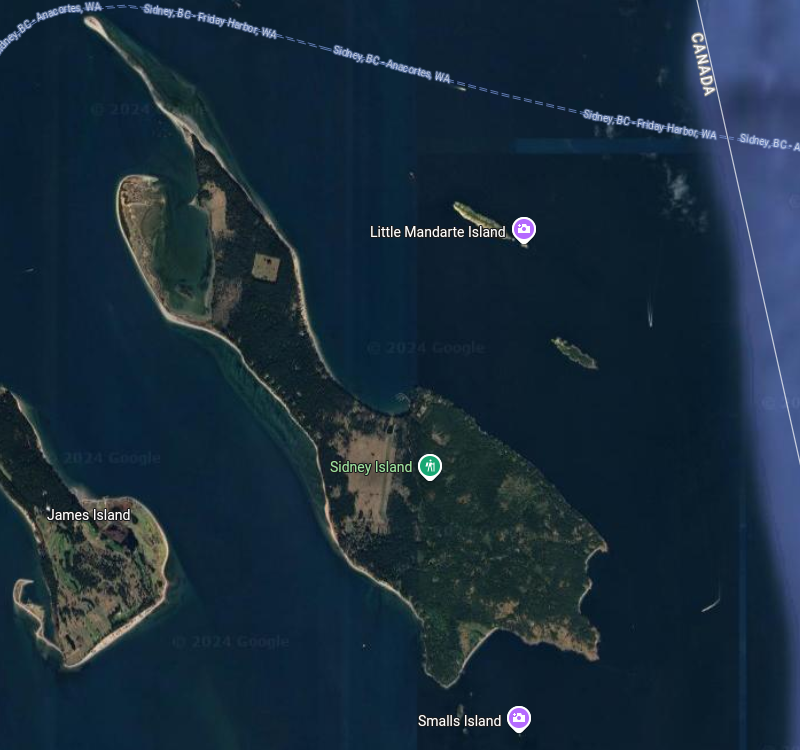
Sidney Island is an 8.6 square kilometer island rougly 5km away from the town of Sidney. The island is divided between a national park on the north, popular with campers and backpackers, and a private strata corporation on the South. The strata oversees some 111 lots, a dock, a grass airstrip as well as the gravel roads connecting it all. Even though the island has dozens of properties and several full time residents, there is no electrical service, municipal water or sewage. The island has no full-time emergency services, nor does it have regular ferry service. Anyone living there needs to be self-reliant, not to mention own a boat, or know someone who owns a boat! Peter, the director of the UVIC lab had purchased some property on the island back in 1991 and was just now looking to utilize it for some of his ham radio projects – setting an HF radio station, along with a microwave data link back to UVIC for Internet service. With me being one of the primary admins for the Victoria extension of the HamWAN microwave network the project was right up my alley!
The day started with an early morning pick-up at my house at 7:30AM sharp. Myself, Peter and Peter’s right-hand man Leve; who manages the day to day of the lab, piled into Peter’s station wagon and began our roughly 30 minute drive to the town of Sidney from where we would take a boat to the island. While I had initially assumed we would be taking Peter’s boat (ahh to be able to afford such a thing), I quickly learned we would be taking a commercial water taxi and would be meeting up with “the rest of the gang” and I began to suspect that more was on the agenda then simply an antenna install.
My suspicions were confirmed. I quickly came to understand that the reason the antenna project was happening on this particular day was because Peter was getting a sick upgrade to his property – a brand new pre-fabricated home!
As introductions were made I began to piece together a few crucial details about the property:
- Since purchasing it, there had never been a permanent living-space installed, instead an RV and shed near the beach served as the only structures
- As he planned to make more use out of the property, Peter had purchased a pre-fabricated home with the intention of using it as his primary dwelling on the island
- Over the course of the last several months, a number of trips to the Island had already been made in order to clear land, dig a foundation, install water storage tanks and generally prepare the property for the building
This day’s excursions were to see the delivery of the completed home and it’s installation onto the foundation and concrete pad. As the installation itself required the use of a crane (the home was to be lifted off a flat-bed truck and onto the foundation) Peter’s plan was to take advantage of the crane being onsite and use it to aid with the install of the amateur radio antenna. Smart plan! Why not make sure the crane was fully utilized since you were paying a small fortune for it to be there in the first place.
Introductions and pleasantries exchanged, the 8 of us crammed ourselves onto the water taxi to begin our journey to the Island.
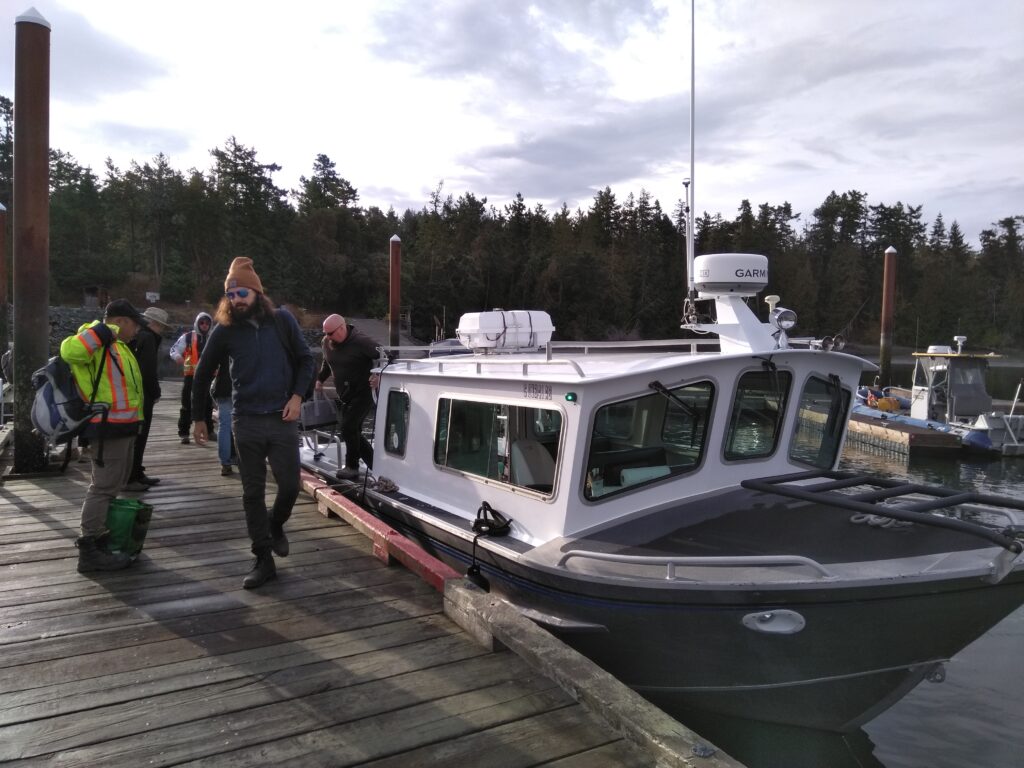
The ride itself was uneventful, and the capable captain of the taxi managed to have us at the dock in just around 20 minutes. This was my first time arriving at the Sidney Island dock, and my first thought was just how they were planning on unloading a house since the wooden peer certainly wasn’t big enough for even the crane, let alone a building! I then spotted a boat ramp into the water which was probably going to be the only viable option for unloading the big stuff. In the end, I took comfort in knowing this was well above my pay grade and most definitely not my problem!
We made quick work of unloading the boat and bombing all the gear up to one of two pickup trucks waiting at the end of the peer. It seemed that the pickups were community-use vehicles, either maintained by the island’s strata council, or possibly just by the residents themselves. Rules were different on the island with insurance, authorized drivers and auto-theft taking on a whole different meaning on this quaint chunk of rock separated from the rest of civilization by 5km of water.
With the gear loaded up, we all piled into the back of the pickup for our journey to the property. I wondered with amusement how many Worksafe rules we could possibly be violating; Island life, Island rules.
Our trip from the dock to Peter’s property took around 10 minutes, and we passed thorough a variety of scenery including old growth forest, a lake, some grassy planes and even a manicured grass airstrip! I guess boat isn’t the only way to get to the island!
Peter’s property was tucked away in some trees, just outside of a community apple orchard which was a hive of activity with people busy harvesting the fruit. The property itself is nearly 5 acres and stretches from the road to the beach below and spans over 200 meters in length. As the truck was unloaded I took a few moments to survey the space.
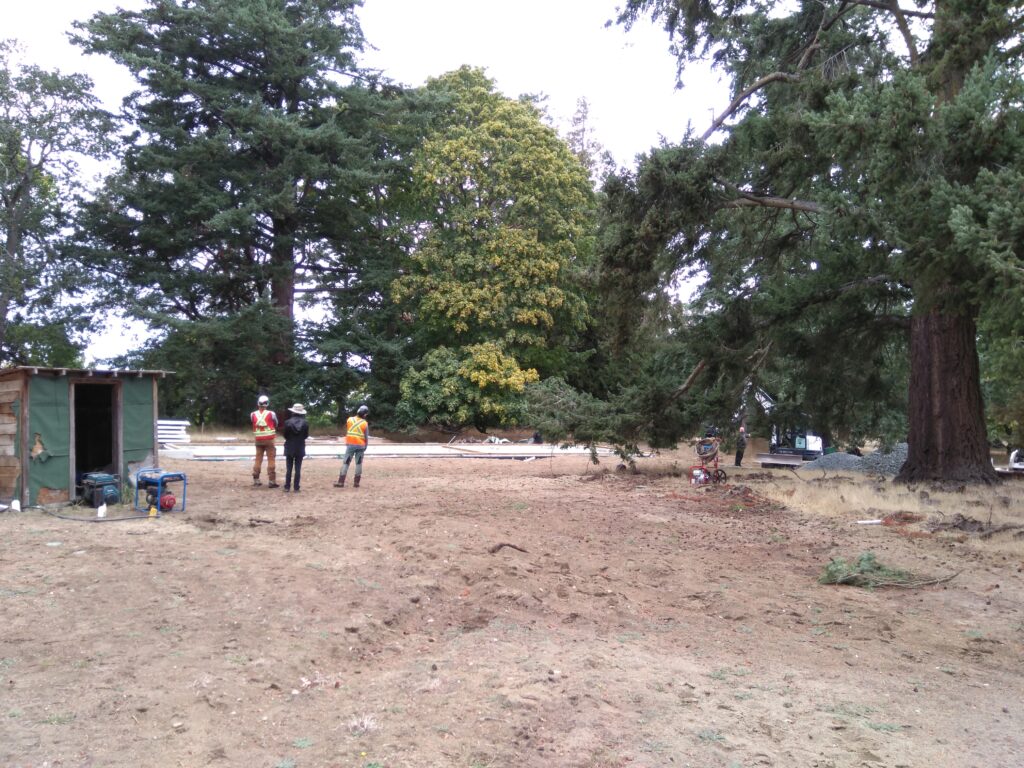
Immediately in front of me was foundation for the building. About 5 meters wide and maybe 15 meters long, the concrete foundation was sunk about 6 feet into the ground. The building would sit on top, and the empty space below would form the basement where the pumps, plumbing and electrical systems would live. Adorning the one side was 3, 1000 gallon water storage tanks which Peter estimated would give more then a month of continuous use. It’s easy to forget that on the island there is no water, sewer, or electrical service – everything needed to be self sufficient! Behind the house was the treeline and beyond that a steep gravel road down to the beach. Peering over the edge, I could just make out the shed and RV which, until today made up the only buildings on the site.
I turned back to the hive of activity around me and wandered over the Leve who was starting work on the amateur radio antenna.
Our first order of business was to make ready Peter’s Hexbeam HF antenna, as this would be installed in one of the old growth trees once the crane arrived. The Hexbeam is a really cool antenna which allows operation on 6 HF bands in a highly compact form factor, perfect for use where space is limited, or for when you want to install your antenna at the top of a 100ft old growth oak tree. Despite it’s appearance, the antenna is actually directional and needs to be paired with a rotor so it can be physically turned in the direction you want to talk. The whole thing really lives up to the age old quote that “antennas are 90% black magic!”
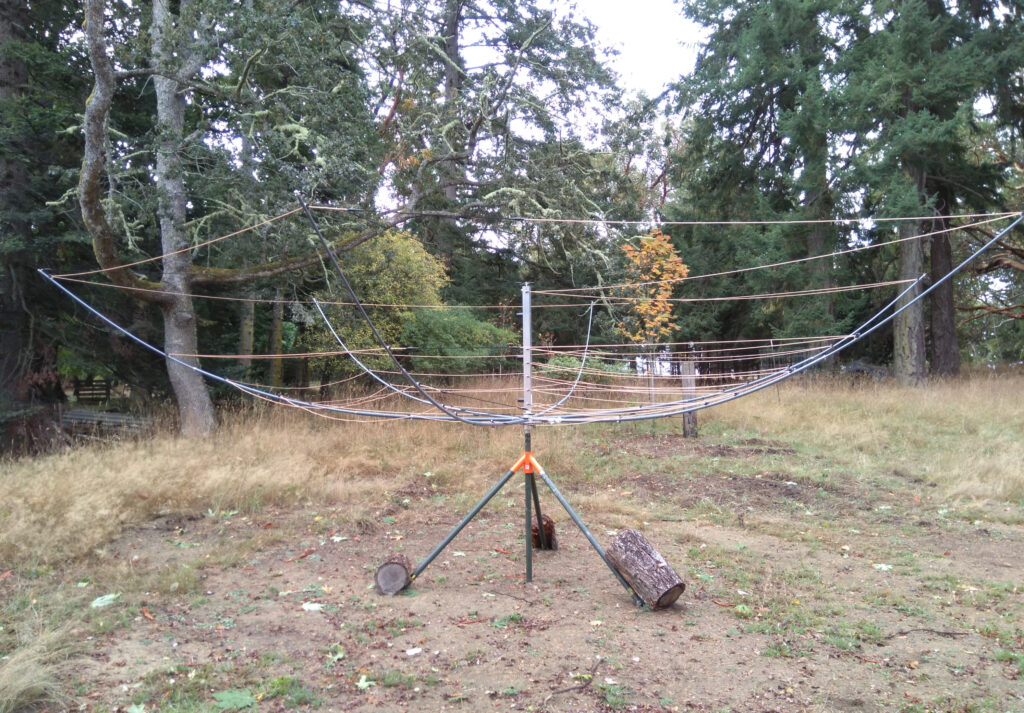
While Leve had already assembled most of the antenna on a previous trip, there were some final adjustments that needed to be made to the antenna’s frame. We also needed to prepare the coax cable and the rotor and get the whole thing mounted onto a mast ahead of the crane’s arrival later in the day.
While Leve spoke on the phone with the antenna manufacturer, I busied myself assembling the rotor and attaching the cable. I realized that Peter had spared no expense for this project – the rotor cable was some of the fanciest I had ever worked with, and the coax cable was premium LMR400. When I think about how much this whole project must have cost him, I suppose the amateur radio antenna portion must be a drop in the bucket. It was nice to be able to work with premium materials – a departure from the usual amateur radio experience!
Leve and I made pretty good time with the HF antenna, and we had the assembly put together in what I would consider a reasonable timeframe.
While our portion of the project was on track, the rest was not. We had received word that the barge which was delivering the house and the crane had been delayed, and it’s arrival was not expected until the afternoon. It was at this point I realized that this project was turning out in much the same way as many of my own – over time and presumably over budget. I looked forlornly into my backpack at my two bottles of water and pair of granola bars – enough sustenance for what I had thought was going to be a trip of just a few hours but what was quickly becoming an all day marathon.
Leve, who had already experienced Sidney Island (and all the things that could go wrong) had over-prepared, and was kind enough to share some lunch with me, so at least I didn’t starve, but I have to admit – by the time I got back home I was famished! Lesson learned – when going to Sidney Island, bring enough provisions for a full day!
By 1PM we finally got some good news, the crane had arrived and was in the process of being unloaded! Hooray! Perhaps we could get this darn antenna up in the tree after-all!
The unloading of the crane was apparently a huge fiat since it didn’t roll down the driveway until about 2:30 in the afternoon. I do regret missing out on the opportunity to see the beast getting unloaded from the barge and driven along the winding roads of the island because the thing itself was huge, with a length clocking in close to 50ft.
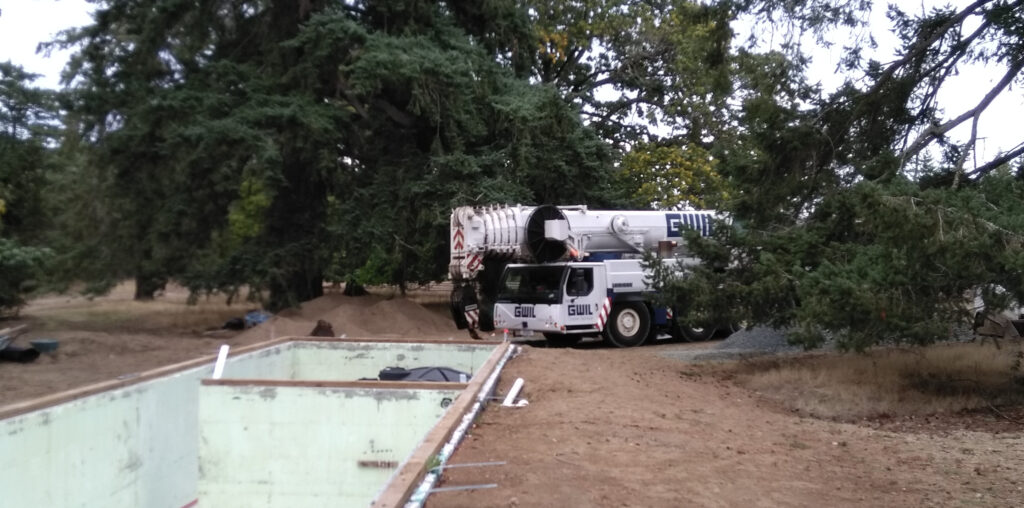
Once the crane was in position, the next problem became apparent; because Peter’s oak tree was so tall, the crane needed extra counterweights to stop from tipping over. Another trip back to the barge and another delay to the project. Eventually, extra counterweights, loaded onto two flat bed trailers, arrived. To this day I am impressed by how much they managed to cram onto that barge!
While all this was happening, the next major unloading project was well under way – Peter’s prefabbed house needed to be unloaded and transported back to the foundation.
The movement of the house was apparently a sight to behold, and something else I regrettably didn’t get a chance to experience. The road itself was too narrow in places, and the crew of arborist’s needed to be re-tasked to lobbing off branches on either side of the flatbed to make the house fit. Following along behind was the house installation crew, picking up branches and debris left behind. I can only picture it as a bizarre parade through the forest, which incredulous residents gawking at the spectacle.
By 5PM the counterweights had arrived, and the crane operator made quick work of dropping them in place. He was remarkably efficient, and, to my untrained eye seemed to be an expert in his craft.
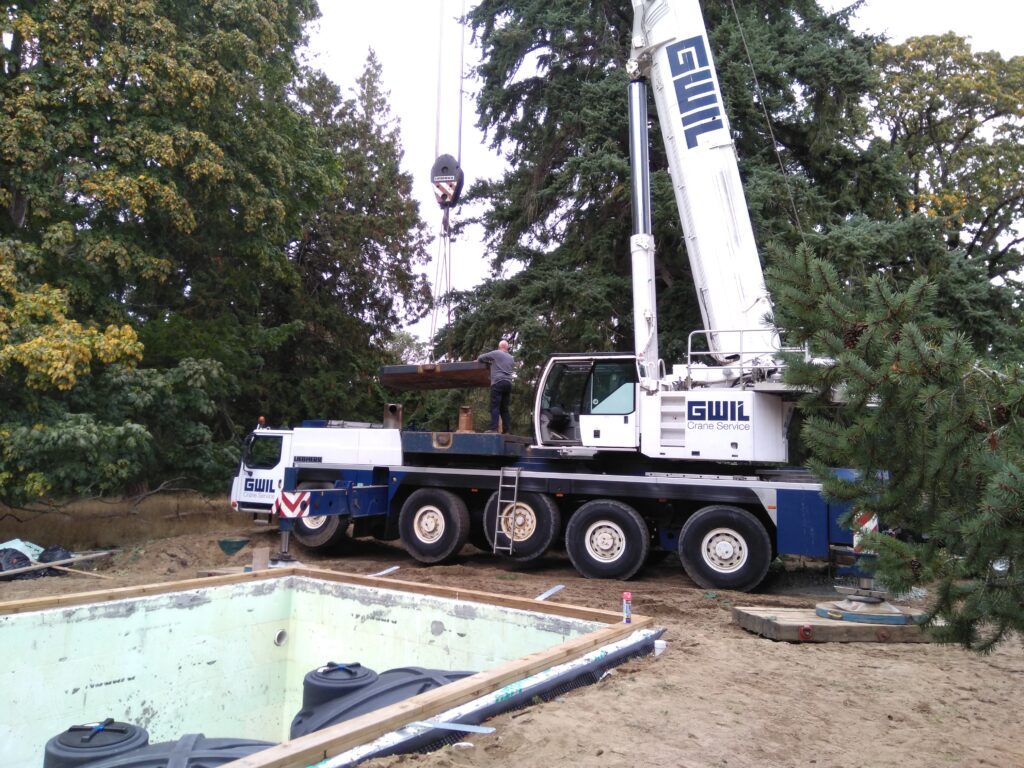
By this time, Leve and I had maneuvered the antenna into the house’s foundation and had it propped up into the air. The crane was able to hook the mast and lift the entire assembly into the air in one fluid motion.
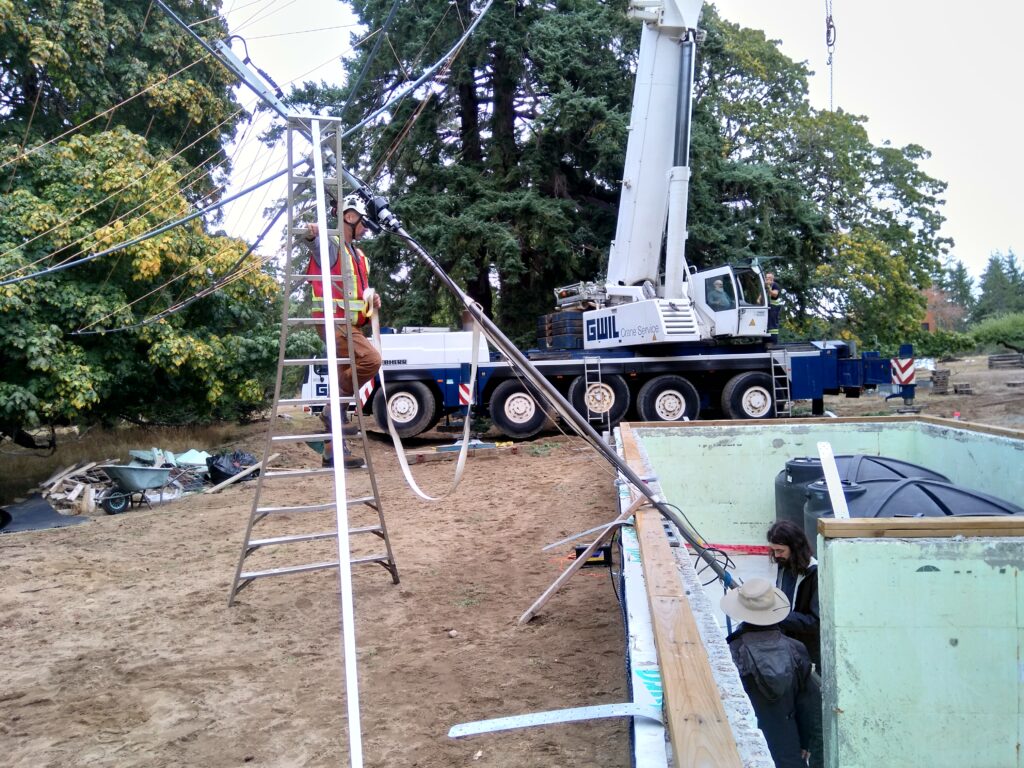
After the weights had been placed, it was just a matter of scooping up the antenna and lifting it up to the tree where there arborists were waiting to scramble up and bolt it in place. The entire antenna install was less then an hour, much less then the total time waiting for everything to be in place.

While the final touches were being put on the antenna, the last crucial piece fell into place – the house itself had arrived!
Peter’s house was maybe 100ft long and sat on the back of a flat-deck trailer, pushed along by a tractor-trailer running in reverse. About a quarter past six we could hear it rumbling along, and soon the outline of the home appeared in the distance. It took maybe 20 minutes for the driver to maneuver the home into position, but sadly that is the last I would see of it since Leve and I, along with the arborists were recalled as our work was done.
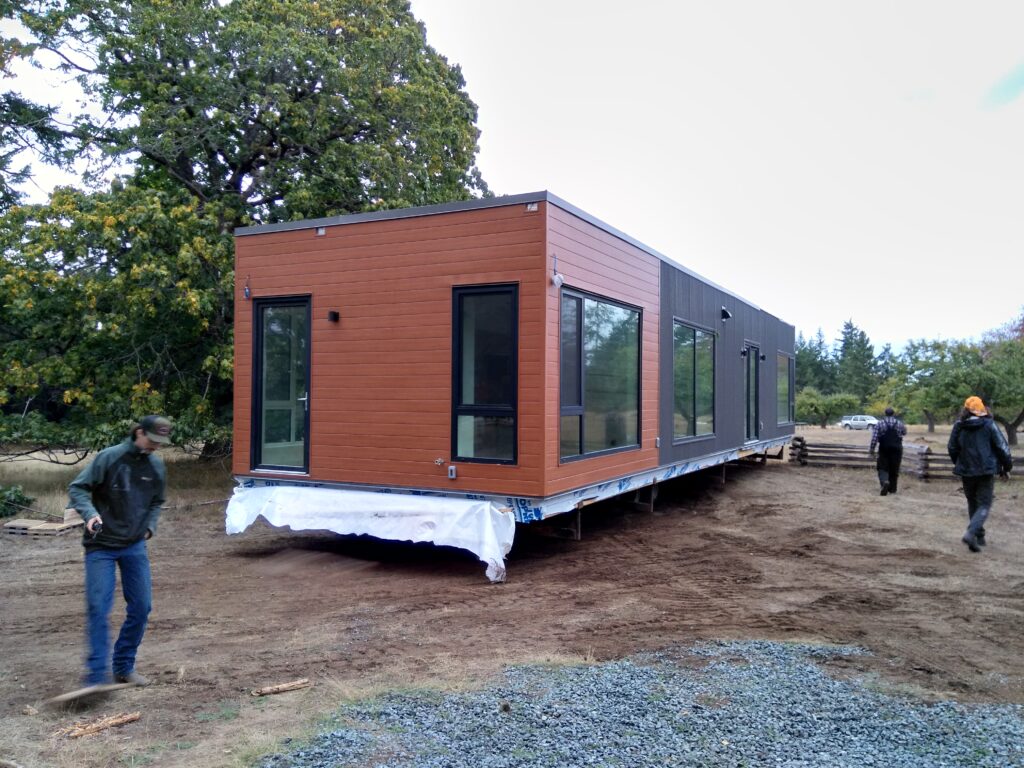
I’ll admit to being a bit miffed to the fact that we didn’t get a chance to test the microwave path from the university to the island, as had been the original plan, but that discontent didn’t last long when I found out a few days later that the rest of the crew didn’t get a chance to leave the island until 2AM! Apparently it was not as simple as pick the house up and drop it ontop of the foundation!
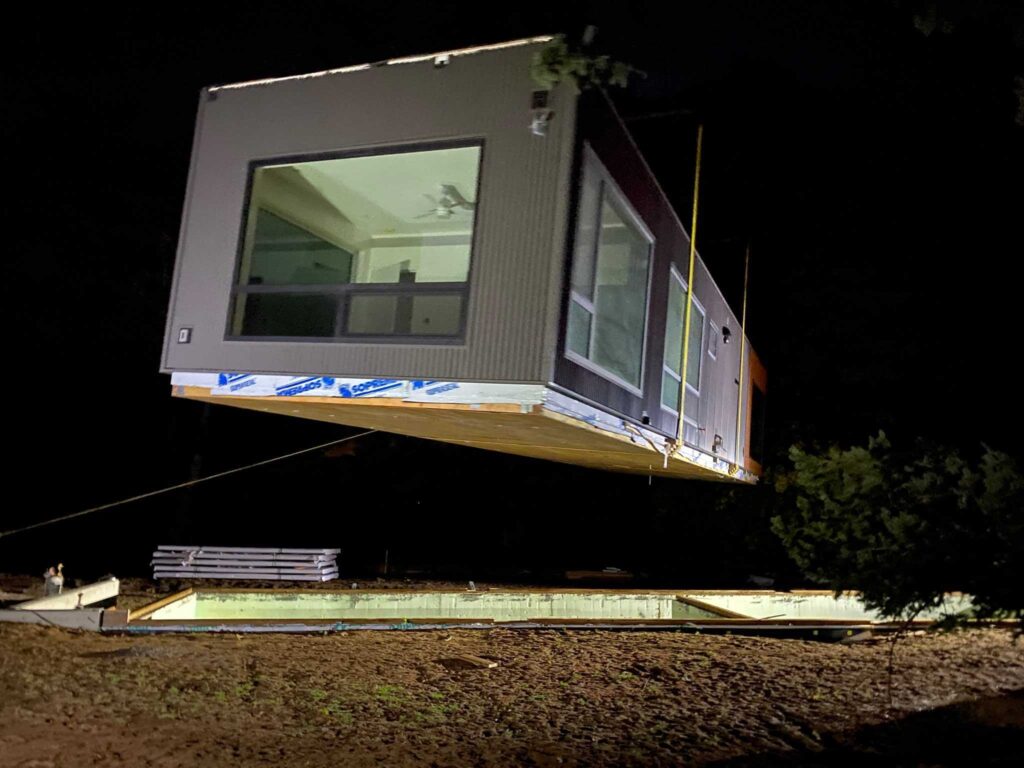
Our final tribulation would come in the form of our transportation back to the city. While I was fortunate enough to line up my father to give Leve and I a ride home, Leve had stored a bunch of items in Peter’s car, which naturally Peter would need when he eventually managed to get off the island. We decided to take Peter’s keys, and then leave them with the front desk of a nearby hotel so he could retrieve them upon his return. The plan clearly worked, since Peter managed to get home, but Leve and I clearly arrived at the hotel during coffee break since there was no front desk agent to be found and the lobby was left completely unattended for the first 20 minutes of our arrival – an experience which I found interesting to say the least. At least it would make a good location for a dead drop.
Overall, I would say that I enjoyed my trip to Sidney Island, despite the fact that I was woefully under-prepared for the duration of time we spent there. Seeing the crane operator work his magic was truly an experience, and the weather was remarkably nice for the end of September. Had I brought more food, lawn chairs and maybe a couple of beers it could have even been considered a vacation.
The Return to Sidney Island
Since we never had the opportunity to test the microwave link, I was wondering when I would receive my next invitation to the island. As it would happen, the next opportunity wouldn’t surface for nearly a year – not until August of 2024 when some electricians and surveyors were scheduled to be out at the property to do some work. In a repeat of the previous story, I found myself awaiting an early morning pickup, this time with more water and a proper bagged lunch.
This trip was much more tame then the previous, instead of multiple crews installing an entire house we were hitching a ride with two surveyors and two electricians. The surveyors only had a couple of hours work, so the expectation was that we would be back before lunch. Nevertheless, after my previous on-island experience, I made sure I had enough food to get me through the day.
Being August, the weather was beautiful, and we managed to time it for a day where the heat was a bearable 22 degrees. Our trip on the water taxi was uneventful and after 20 minutes on the water and 10 in the back of a pickup I found myself once again at Peter’s property.
This was my first time seeing the installed house, and I must say for off-grid living, it looked pretty damn nice. The main common area boasted a full kitchen, the bathroom looked like something you’d expect to see in a fancy hotel, and every room had a heat pump to keep the temperature comfortable. The house was far from complete; every room was filled with debris, the plumbing wasn’t finished and the electrical was a work in progress, but the place had potential – and I’m sure it’s going to be spiffy once it’s done.
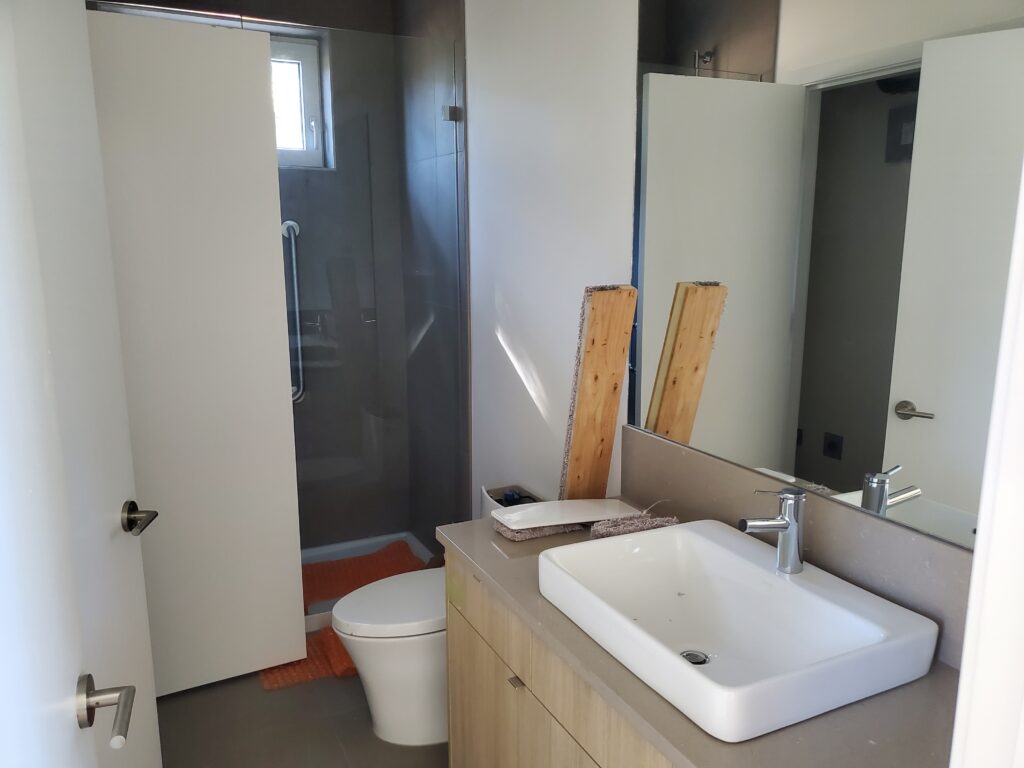
My tour of the property complete, Leve and I hiked down to the beach to begin our microwave experiments.
Peter’s property is roughly 150ft above the beach, which you would expect is a benefit for line of sight microwave, however, what it gains in height it looses in foliage – the entire property is shaded from view of the university, the town of Sidney, and really anyplace that would have a chance of providing network access, and so the beach, outside of the shelter of the trees was the place to be to test our coverage.
After some futzing with the dish (why are these things never configured property out of the box) we got it mounted atop a quick deploy tripod setup (military surplus for the win) and before long we were scanning the skies for signals.

Our mission was ultimately a success – while we did manage to see microwave beacons from the university, the real surprise came when we spotted a -70 dB signal off the side of a recently installed HamWAN node in Saanich – just a few kilometers from my house! At last the trip was a success!
Leve and I hiked back up to the house and had a look at what the electricians were up to; the answer? batteries, so many batteries. Because the island is completely off grid, everyone is responsible for generating their own power, and Peter’s plan was to run solar, and if there is one thing I discovered with my Coronation property experience it was that to run for any length of time on solar you needed a hell of a lot of battery capacity! And this needed to be enough capacity to run an entire house; including appliances and climate control! I shudder to think what the entire setup cost since batteries are not cheap, especially these fancy Lithium-Ion cells.

Our visit was cut short once the surveyors finished their work and were eager to head back, so Leve and I hitched a ride around 11:30, least we should be stranded on the island until the electricians finished their work. This quick expedition to the island marked the end of the first chapter in the Sidney Island saga, but given that we now needed to construct a tower on the beach, I suspect it won’t be the last!